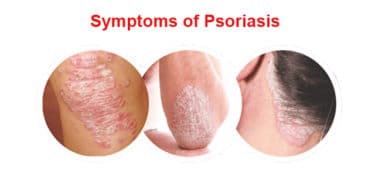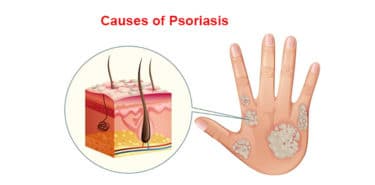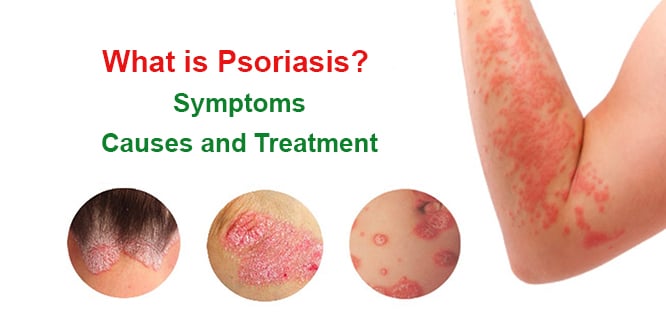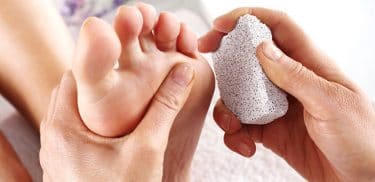Psoriasis is a type of chronic immune system (autoimmune) disease due to accelerated regeneration of skin cells. Rapid regeneration of skin cells lead to scaling and dandruff. There is inflammation and redness around the scales. Psoriasis can be seen at any age and gender, however, it more common in adults. Especially if you have psoriasis in family history, there is an increased risk. Psoriasis is not a contagious disease; skin contact does not transmit the disease. There is no definitive medication to cure psoriasis but new drugs can alleviate inflammation and plaques, and the disease can regress significantly.
Table of Contents
What is psoriasis?
The scales generally have a whitish-silver color and seen on thick, red patches. In some cases these patches can be blooded and cracked. Main reason of psoriasis is abnormally rapid skin cell overproduction. Under normal conditions, skin cells grow deep in the skin and slowly rise to the surface. Then they start falling off. This life cycle generally takes one month.
In people with psoriasis, this skin cell production may occur in a matter of days. Therefore, skin cells don’t have the time to fall off; this is the main reason of it. Scales in psoriasis generally develop on joints, such as elbows and knees. In addition to elbows and knees, scales may develop in hands, feet, face, scalp, neck and other parts of the body. Less common types of psoriasis can affect nails, mouth, and even the area around genitals.
Psoriasis is associated with several other diseases like type 2 diabetes, cardiac diseases, arthritis, high blood pressure (hypertension), obesity, inflammatory bowel disease. Although the exact cause of it is unknown, familial predisposition, namely genetics, are considered to be the most important cause of the disease.
As psoriasis has a similar appearance to other skin problems, diagnosis can be difficult. Skin creams, ultraviolet light therapy, prescribed drugs or combination of multiple different treatment methods can be preferred for its treatment. (1)

Who has psoriasis?
It can be seen at any age and males and females are equally affected, and it is generally diagnosed in adulthood. The average age of onset is 33. Almost 75% of the patients encounter symptoms before the age of 46. A second peak period of the disease can occur in late 50s and 60s.Psoriasis risk is very low for people with light skin.
People with psoriasis in their family background are at a higher risk. However, many people with the condition have no family history at all and some people with a family history won’t develop psoriasis.
Types of psoriasis
There are 5 different types: (2)
Plaque psoriasis
It is the most common type of psoriasis and causes red, inflamed patches that cover areas of the skin. These patches generally have whitish-silver scales or plaques. These plaques are commonly observed on the elbows, knees, and scalp. About 80 percent of people with the condition have plaque psoriasis.
Guttate psoriasis
Its is common in childhood and causes small pink spots on the skin. These spots generally occur on arms, legs and torso. These spots are rarely thick and plaque-shaped.
Pustular psoriasis
It is more common in adults and causes white, pus-filled blisters and red, inflamed areas spread to certain parts of the skin. This type is typically localized to smaller areas of the body, such as the hands or feet, but it can spread in some cases.
Inverse psoriasis
It causes patches to develop under armpits, in the groin, chest and genitals. These inflamed patches around skinfolds are generally red and bright.
Erythrodermic psoriasis
This is a rare type of psoriasis and often covers large sections of the body and patches resemble sunburn. Patients can be very vulnerable against other diseases and have frequent fever attacks.
Symptoms of psoriasis
- Reddish, slightly raised, inflamed skin spots and patches
- Whitish-silver plaques and scales on the red spots
- Cracked and bloody dry skin around the patches
- Itchiness and sense of burning around the patches
- Joint pain

Not every patient suffers from all these symptoms. Especially in rare types of psoriasis, patients can experience completely different symptoms. Patients go through different symptom cycles. Symptoms of the disease may go away and patient does not suffer from any symptom. However, the same patient can experience even worse and advanced symptoms after a while.
And sometimes symptoms can completely disappear. Chronic psoriasis disease may enter into ‘remission’ where you experience less or no symptoms at all. And you can suffer from serious psoriasis symptoms during ‘flare-up’.
Causes of psoriasis
There is no consensus among doctors about the exact cause of psoriasis. However, years of studies indicate that there may be two main bases for it. (3)
- Immune system (autoimmune): Psoriasis is an autoimmune disease, where the immune system attacks healthy skins; white blood cells are normally conditioned to fight off harmful bacteria and infections. However, as a result of wrong conditioning, skin cells start overproduction. And rapid overproduction of skin cells causes red, inflamed plaques and patches on the skin.
- Genetic factors: People with psoriasis in their families have a higher risk. However, this likelihood is as low as 3%.

Triggering or worsening factors of psoriasis
- High stress
- Excessive alcohol use
- Skin injuries like laceration
- Lithium and antimalarial containing drugs like hypertension medication etc.
- Infections
- Weather changes that may cause dry skin
- Sunburn
How is psoriasis diagnosed?
Your doctor may perform two different tests for diagnosis; Physical examination and biopsy. (4)
- Physical examination: As the symptoms are very typical, your doctor can easily diagnose psoriasis through a physical examination. Show all patch areas to your doctor and tell if you have anyone with psoriasis in your family.
- Biopsy: Your doctor may collect skin samples if your samples are mild. Exact diagnosis can be made after the examination of tissue samples under the microscope.
Treatment of Psoriasis
Although there is no treatment that permanently ends psoriasis, it is possible to reduce inflammation and plaques, and prevent overproduction of skin cells. New and modern treatments can significantly reduce the symptoms for the patients. There are 3 main treatment categories: (5)
Topical treatment of psoriasis
Creams and ointments applied directly to the skin can be helpful for reducing mild to moderate psoriasis. Topical treatment includes:
- Topical retinoids and corticosteroids
- Vitamin D analogues
- Moisturizers
- Salicylic acid
- Anthralin
Medical treatment of psoriasis
Oral or injected medication can be used for those who do not respond to topical treatment. However, as these drugs can have serious side effects, doctors usually prescribe them for short periods of time. Methotrexate, cyclosporine, retinoid containing drugs and biologics are preferred for medication.
Retinoids slow skin cell production and cyclosporine, biologics and methotrexate suppresses the immune system response. But since methotrexate and cyclosporine use can lead to serious side effects, these drugs must be prescribed by your doctor.
Light therapy for psoriasis
Mild and moderate symptoms can reduced with light therapy by using ultraviolet or natural light. Combination of light therapy and abovementioned methods can be used for the treatment of moderate and severe symptoms. Treatment method can be changed if results are not successful.
Herbal treatment for psoriasis
In recent years, people frequently refer to herbal medicine and you can also benefit from following herbs for the treatment of psoriasis.
However, consult your doctor first before using any herbs in order to avoid any possible side effects! Otherwise, you may encounter unwanted results.
Aloe Vera
Aloe Vera regenerates skin cells and repairs irritated skin, and it is also very successful in preventing redness and stopping inflammation. Apply a topical cream containing at least 5% Aloe Vera to the affected skin areas at least three times a day for 5 days to reduce the symptoms.
Oregon Grape
Oregon grape, a type of berry, has anti-inflammatory properties and provides successful results in the treatment of psoriasis. Powderize and distill the root and leaves of the herb to obtain a cream and apply it on the patches and scales. You can alleviate the redness during flare-up periods of the disease.
Turmeric
Turmeric is another herb that you can use for the treatment of psoriasis thanks to its antibacterial properties. You benefit from these properties by adding a pinch of turmeric to your foods.
Recommendations for psoriasis patients
- You can reduce the symptoms by getting rid of excess weight.
- Consume food rich in Omega 3 and low in saturated fat, such as salmon, sardine, shrimp, flax seed and walnut.
- Avoid processed food, refined sugar and red meat, which can trigger the disease.
- Avoid alcohol at all times.
- Immediately quit smoking.
- Enhance your immune system with vitamin supplements.
- Develop management methods against stress, which is a trigger of psoriasis, by attending to activities like meditation and yoga.
- Take care of your physical health as well as your mental health. You can consult an expert or bond friendships with a group people who suffer from psoriasis.
- Moisturize your skin regularly during the day.
- Do not forget to visit your doctor periodically.




